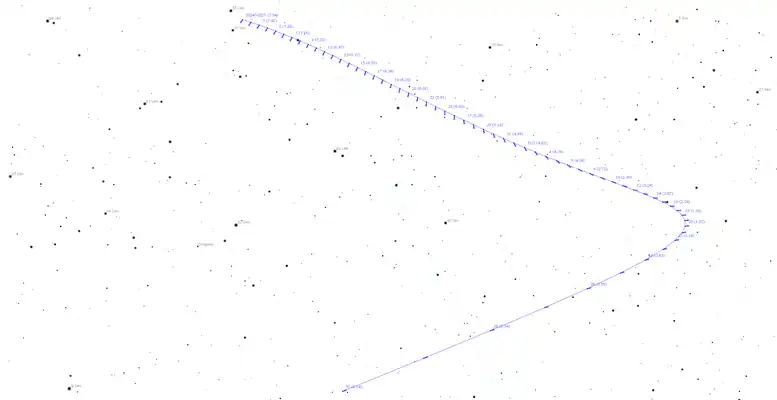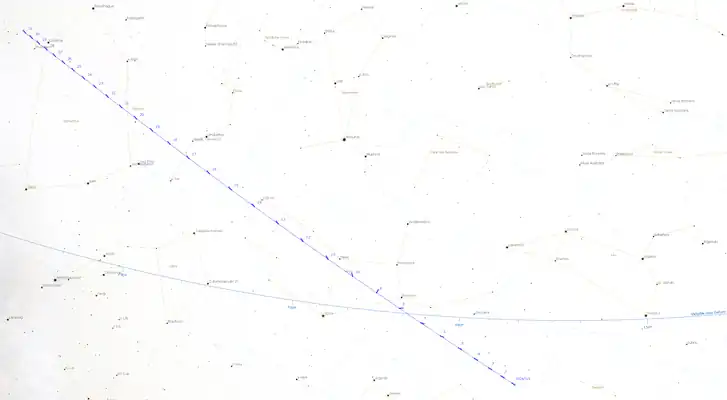 Images of comet C/2023 A3 (Tsuchinshan–ATLAS) obtained on 2023-02-24 at remote telescopes by amateur astronomer | |
| Discovery | |
|---|---|
| Discovered by | Purple Mountain Observatory ATLAS South Africa |
| Discovery date | 9 January 2023[1] |
| Designations | |
| C/2023 A3 | |
| A10SVYR | |
| Orbital characteristics[2] | |
| Observation arc | 1.37 years (502 days) |
| Earliest precovery date | 9 April 2022 |
| Number of observations | 2060 |
| Aphelion | 90000+ AU (inbound)[3] |
| Perihelion | 0.3914 AU (58.6 million km)[4] |
| Eccentricity | 0.999992 (epoch 1800)[3] 1.000008 (epoch 2200) |
| Orbital period | millions of years (inbound)[3] possible ejection (outbound) |
| Max. orbital speed | 67.33 km/s @ perihelion[4] |
| Inclination | 139.1° |
| 21.56° | |
| Argument of periapsis | 308.5° |
| Next perihelion | 27 September 2024 18:00 ± 20 minutes (3-sigma)[4][2] |
| Earth MOID | 0.275 AU (41.1 million km; 107 LD)[2] |
| Comet total magnitude (M1) | 6.1 ± 0.3[2] |
| Comet nuclear magnitude (M2) | 9.2 ± 0.3[2] |
C/2023 A3 (Tsuchinshan–ATLAS) is a comet from the Oort cloud discovered by the Purple Mountain Observatory on 9 January 2023 and independently found by ATLAS South Africa on 22 February 2023. The comet will pass perihelion at a distance of 0.39 AU (58 million km; 36 million mi) on 27 September 2024,[1][4] when it could become visible to the naked eye.[5][6][7] As of September 2023, the comet is currently 5.5 AU (820 million km; 510 million mi) from the Sun, approaching at 17.9 km/s, with an uncertainty region of ±8,000 km.[8]
Observational history
During the search performed by Asteroid Terrestrial-impact Last Alert System using the 0.5-m f/2 Schmidt reflector at the Sutherland Observatory in South Africa an asteroidal object with an estimated magnitude of 18.1 was detected in images taken on 22 February 2023, when the comet was about 7.3 AU (1.09 billion km; 680 million mi) from the Sun.[9] After the first orbit calculations it was noticed that it was the same as an 18.7 magnitude object reported to the Minor Planet Center by the Purple Mountain Observatory that was detected in images taken on 9 January 2023. It was entered in the objects waiting confirmation list but after no follow up observations were reported, it was removed in 30 January 2023 and was considered lost.[9] Based on the naming conventions of comets, the comet received the name of both observatories.[9]
The object was subsequently detected in images taken by Zwicky Transient Facility (ZTF) in Palomar Observatory on 22 December 2022, when it had a magnitude of 19.2–19.6. These images also revealed it had a very condensed coma and a small straight tail 10" in length, indicating it was a comet.[1] More evidence of cometary activity were reported by Hidetaka Sato, M. Mattiazzo, and Cristóvão Jacques.[9]
Upon discovery announcement the comet was estimated to reach a total magnitude of +3 during perihelion, assuming an absolute magnitude (H) of 7 and 2.5n = 8, when it will be in low solar elongation.[9] Maximum brightness may occur about three weeks after perihelion, in mid October, when it is estimated to be of fourth magnitude.[9] Gideon van Buitenen estimated that the comet will reach a magnitude of 0.9 during perihelion and −0.2 at the time of the closest approach to Earth, assuming H = 5.2 and 2.5n = 10, and will benefit from the effects of forward scattering.[10][11] On 9 October 2024 the comet will be 3.5 degrees from the Sun.[12]
Orbit
The comet has a retrograde orbit, laying at an inclination of 139°. Τhe comet has its perihelion on 27 September 2024, at a distance of 0.391 AU. Τhe closest approach to Earth will be on 12 October 2024, at a distance of 0.47 AU. The comet doesn't approach close to the giant planets of the Solar System.[9] The orbit is weakly bound to the Sun before entering the planetary region of the Solar System.[3] Due to planetary perturbations, the outbound orbit will have a greater eccentricity than the inbound orbit and is not bound to the Sun as it is weakly hyperbolic.[3] The weakly hyperbolic trajectory may or may not result in the comet being ejected from the Solar System. It is expected to be 200 AU from the Sun in the year 2237.[13]
| Date and time of closest approach |
Earth distance (AU) |
Sun distance (AU) |
Velocity relative to Earth (km/s) |
Velocity relative to Sun (km/s) |
Uncertainty region (3-sigma) |
Constellation | Moon illumination |
Reference |
|---|---|---|---|---|---|---|---|---|
| 2024 October 12 15:18 ± 15 min | 0.472 AU (70.6 million km; 43.9 million mi; 184 LD) | 0.556 AU (83.2 million km; 51.7 million mi; 216 LD) | 80.5 | 56.5 | ± 7 thousand km | Virgo | 70% | Horizons |
- Positions of the comet C/2023 A3 in autumn 2024
 The position of comet C/2023 A3 in August and September 2024 with the expected apparent magnitudes. The comet is located in the constellation Leo (Leo) between the two stars 55 and 57 Leonis about six degrees south of the ecliptic at the beginning of August and then moves towards the constellation Sextans. With increasing apparent brightness, it turns back toward the constellation Leo in the second half of September at maximum southern ecliptic latitude (just under 14 degrees of arc).
The position of comet C/2023 A3 in August and September 2024 with the expected apparent magnitudes. The comet is located in the constellation Leo (Leo) between the two stars 55 and 57 Leonis about six degrees south of the ecliptic at the beginning of August and then moves towards the constellation Sextans. With increasing apparent brightness, it turns back toward the constellation Leo in the second half of September at maximum southern ecliptic latitude (just under 14 degrees of arc). The position of comet C/2023 A3 in October 2024. The comet is located in the southernmost tip of the constellation Leo about ten degrees south of the ecliptic and moves in the first half of the month with decreasing apparent brightness across the constellation Virgo. It then moves into the western head of the constellation Serpens Caput, and then moves across the constellation Ophiuchus. By the end of the month, the comet reaches a northern ecliptic latitude of just over 27 degrees of arc. Therefore, in the second half of October the comet should be well visible on the western horizon after sunset.
The position of comet C/2023 A3 in October 2024. The comet is located in the southernmost tip of the constellation Leo about ten degrees south of the ecliptic and moves in the first half of the month with decreasing apparent brightness across the constellation Virgo. It then moves into the western head of the constellation Serpens Caput, and then moves across the constellation Ophiuchus. By the end of the month, the comet reaches a northern ecliptic latitude of just over 27 degrees of arc. Therefore, in the second half of October the comet should be well visible on the western horizon after sunset.
References
- 1 2 3 "MPEC 2023-D77 : COMET C/2023 A3 (Tsuchinshan–ATLAS)". minorplanetcenter.net. Retrieved 1 March 2023.
- 1 2 3 4 5 6 "Small-Body Database: C/2023 A3 (Tsuchinshan-ATLAS)". ssd.jpl.nasa.gov. Archived from the original on 2023-03-01. Retrieved 1 September 2023.
- 1 2 3 4 5 Horizons output. "Barycentric Osculating Orbital Elements for Comet C/2023 A3 (Tsuchinshan-ATLAS)". Retrieved 2023-09-01. (Solution using the Solar System's barycenter (Sun+Jupiter). Select Ephemeris Type:Elements and Center:@0)
Epoch 1800 was PR= 3.6E+9 / 365.25 days = millions of years - 1 2 3 4 "Horizons Batch for C/2023 A3 (Tsuchinshan-ATLAS) on 2024-Sep-27" (Perihelion occurs when rdot flips from negative to positive). JPL Horizons. Archived from the original on 2023-04-04. Retrieved 2023-09-01. Perihelion as defined at epoch 2024-Sep-01 is QR= 3.91402E-01 (0.3914 AU).
- ↑ D'Anna, Pasquale (28 February 2023). "Arriva una nuova cometa forse visibile ad occhio nudo!". Passione Astronomia (in Italian). Retrieved 1 March 2023.
- ↑ "New comet – C/2023 A3 – could be bright in 2024". earthsky.org. 3 March 2023. Retrieved 8 April 2023.
- ↑ King, Bob (16 March 2023). "Anticipating Comet Tsuchinshan-ATLAS (C/2023 A3)". Sky and Telescope. Retrieved 8 April 2023.
- ↑ "Horizons Batch for C/2023 A3 (Tsuchinshan-ATLAS) for September 2023" (uncertainty (RNG_3sigma) is 3-sigma). JPL Horizons. Archived from the original on 2023-09-01. Retrieved 2023-09-01.
- 1 2 3 4 5 6 7 "Electronic Telegram No. 5228". Central Bureau for Astronomical Telegrams. 28 February 2023. Retrieved 1 March 2023.
- ↑ "C/2023 A3 (Tsuchinshan–ATLAS)". astro.vanbuitenen.nl. Archived from the original on 1 March 2023. Retrieved 1 March 2023.
- ↑ Seiichi Yoshida. "C/2023 A3 ( Tsuchinshan-ATLAS )". Seiichi Yoshida's Comet Catalog. Retrieved 2023-05-01.
- ↑ "Horizons Batch for C/2023 A3 (Tsuchinshan-ATLAS) Solar elongation on 2024-Oct-10". JPL Horizons. Retrieved 2023-03-03.
- ↑ C/2023 A3 outbound at 200 AU
External links
- C/2023 A3 at the JPL Small-Body Database

.png.webp)
.png.webp)

